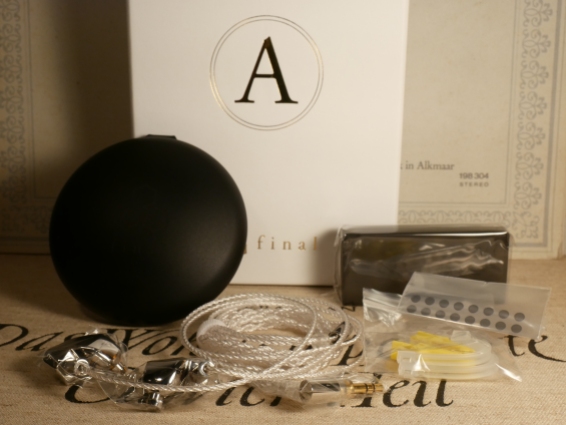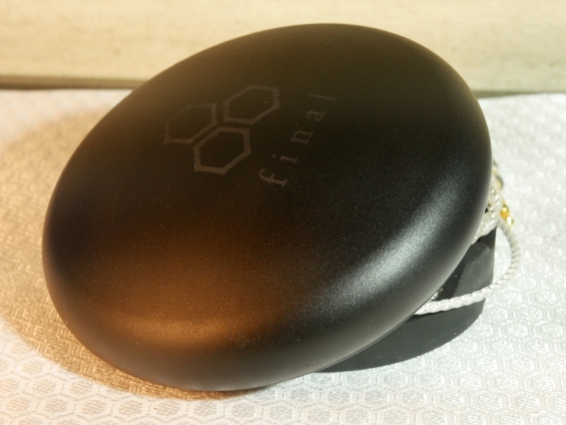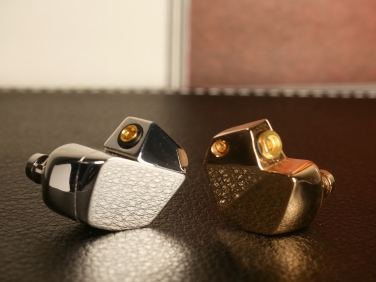FINAL AUDIO A8000 REVIEW

TONALITY: 9/10
TECHNICALITIES: 9.5/10
CONSTRUCTION&DESIGN: 9/10
PACKAGING&ACCESSORIES: 8.5/10
VERSATILITY: 9.5/10
VALUE: Cannot Apply (but it’s the nearest to perfection IEM I ever heard)THE PLUS: Extremely clear, transparent and accurate sound, fastest transient response I ever heard from a dynamic IEM, multi-layered spatiality, perfect tonality, nuanced timbre, excellent bass response, snappy attack, detailed and controlled treble, hyper-realist musicality, enjoyable male and female vocal, versatile tuning, deep soundstage, sturdy construction,
THE SO-SO: Housing prompt to scratch and fingers prints, the packaging isn’t unique enough, housing is very big and will perhaps not fit every ear, an extra or a unique Final cable would have been welcome because full SPC cable isn’t the best pairing for the A8000, need good power and clean amping to shine
FINAL AUDIO story begins more than 40 years ago (1974), when Kanemori Takai established the FINAL company by creating high-fidelity audio products for turntable ranging from high-end cartridges to amps and speakers. The first product ever created was a revolutionary turntable cartridge designed by Yoshihisa Mori that deliver highly precise and clear sound and was highly regarded by audiophiles at the time. After numerous years in sound system hifi engineering, Mr. Takai joins with Mr.Yamagushi (a Sony developer for Pro acoustic equipment) and create S’NEXT OEM audio company as a subsidiary of Molex LLC that is a big OEM of audio components.
From 2007 to 2013, FINAL mostly create headphones and earphones for other companies, gaining experience with different audio technology and research. In 2011, they even do earphones assembly trial sessions that became very popular among curious audiophiles in Japan. This kind of event is still offered today by Final Audio, which proves they have a rich passion for sharing knowledge about tuning and audio engineering in general.
All begin in 2013 when they launch their first official headphones under FINAL name. After this, research intensifies for audio engineering, creating new types of earphones housing that will inflict on acoustic rendering. Since then, they mostly concentrate on earphones technology, even if they create high-end Dynamic and Planar headphones.
FINAL have a lot of experience in audio technology, which is enriched by both past, present and future knowledge. Their passion for the different acoustic phenomenon is at the core of their audio quest and evolve from niche high end offering like the Sonorous and LabII to ultra-budget IEM like the E series. Whatever the price range of their products, FINAL always dedicated themself to offer a mature balanced sound that both audiophile and audio enthusiasts can enjoy.
FINAL is one of the audio company I respect the most because they are transparent about every aspect of their audio product, they explain with great humility and generosity what sound experience you can expect from any of their earphones or headphones, describing in great details what was the tuning goal and what acoustic rendering they aim.
After reviewing the whole E and B series, as well as F4100 and F3100, I’m even more passionate about FINAL creation. While they have a ‘’house sound’’ I would call as balanced and mature tuning, they never repeat themself and always offer different sound perspectives, should it be about imaging, dynamic nuance, timbre, clarity and lately, transparency.
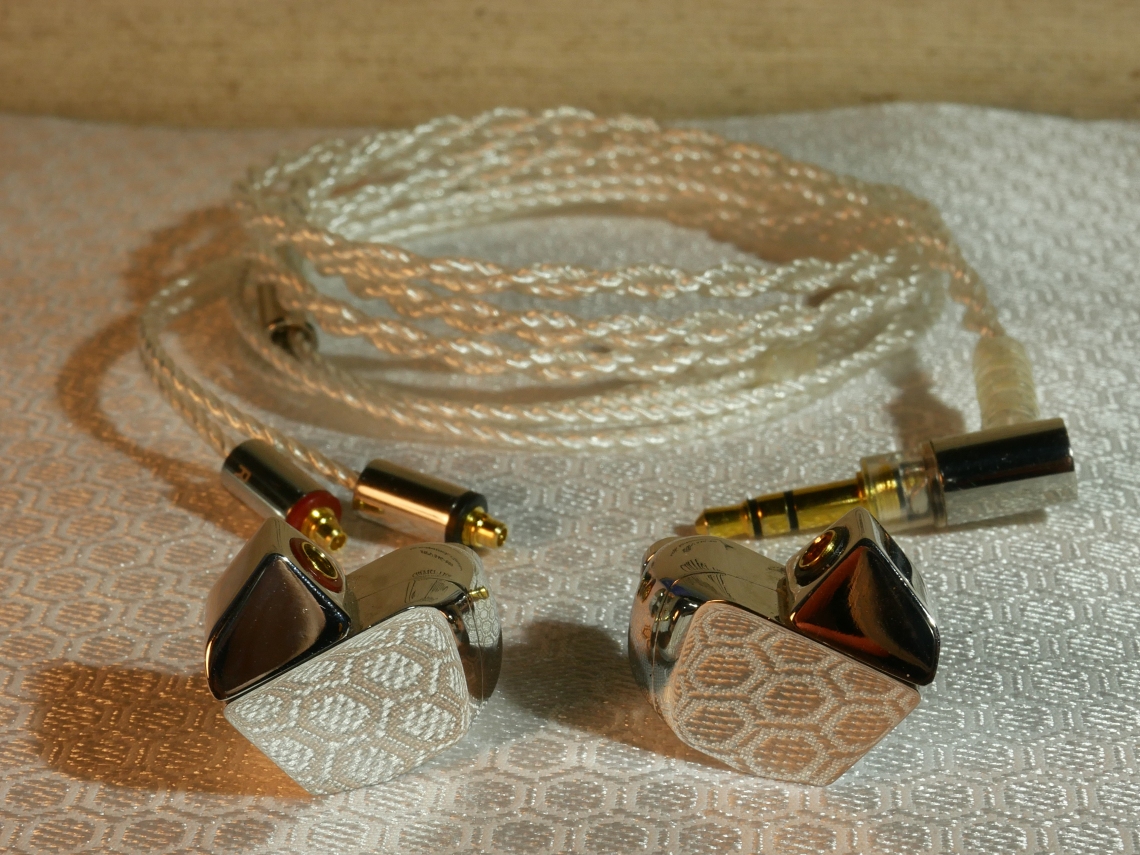
The FINAL A8000 leitmotiv is Transparency of sound layers perception, which is something that cannot be measure and could only be achieved by a lot of testing of different drivers and acoustic chambers. One of the most important factors to achieve this acoustic phenomenon is the transient response of the drivers used, but we have plenty of types like a balanced armature, dynamic, planar, electro-magnetic and so on. After testing multiple audio drivers to find the one that can be fast enough to push simultaneously different sound wave that will be layered fast enough without losing the air within timbre that permits fluid transparency, they conclude only a 100% pure beryllium diaphragm with highly powerful neodymium magnet can achieve this impulse audio response prowess. And after years of research, the A8000 was birth.
At 2000$, the FINAL A8000 is a luxury audiophile earphones that only wealthy people can afford. This isn’t about value, this is about the absolute sound perfection quest. Is this the end game earphones of audiophile utopist? Let’s see in this review if the A8000 delivers a versatile high-end sound or is more aimed for specific music which makes it more a niche audiophile caprice than end game IEM.
You can buy the A8000 from authorized seller like AUDIO46
More info about FINAL AUDIO can be found on their website.
SPECS
Product code: FI-A8DSSD
Housing: Stainless
Driver: Dynamic driver(Truly Pure Beryllium Diaphragm)
Connector: MMCX
Cable: OFC silver coated cable
Sensitivity: 102dB
Impedance: 16Ω
Weight:41g
Cord length: 1.2m
INTERN
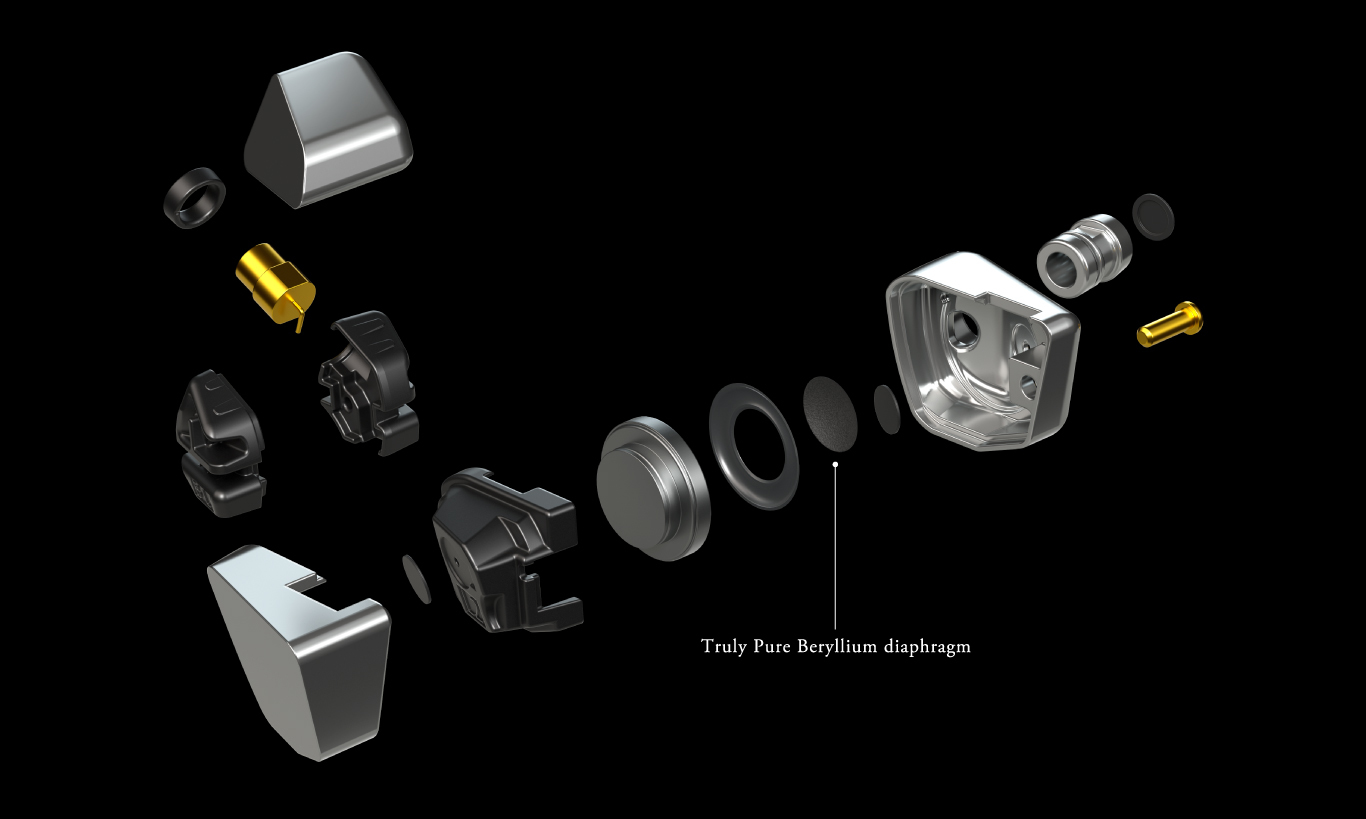
The star of the show here is the pure beryllium diaphragm used for the dynamic driver. Unlike other coated beryllium diaphragm drivers that have to deposit thin coat of beryllium onto a resin film that will still keep its inner transient response and inflict on overall impulse speed, the A8000 use 100% pure beryllium foal crafted together. This is a very complex nanotechnology achievement, and the result is an extremely flexible and durable diaphragm that can achieve a surreal sound propagation velocity of 12,900m/s. Sound is air vibration that goes at different waving speed, it’s very complex to reproduce multiple sounds at the same time because of different frequencies speed like the bass is slow waveform while highs are ultra-fast, the diaphragm is like your speaker’s woofer, but it does not only need to be sensitive to every current push but be able to contract-retract extremely fast too to keep silence between sounds. FINAL quest of transparency in sound means they must find the fastest driver possible, which means it must be ultra-thin but ultra-solid too. Every micro-seconds are important, as this permit to produce transparent layering of sound.
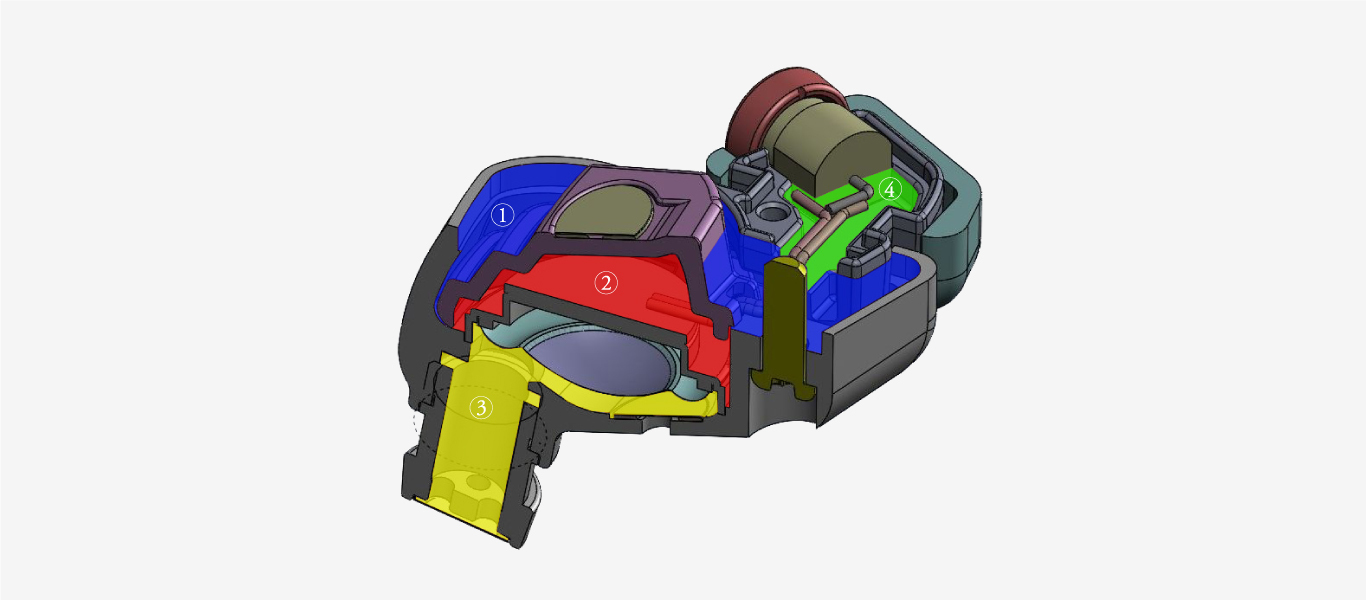
To help cohesive sound reproduction in spatiality, the A8000 uses a ”tetra-chamber construction” for acoustic projection. The size and shape of 4 sound chambers inflict on sound quality, especially in keeping the bass thigh and well separated from other frequencies, as well, imaging improvement in spatial separation. As seen in the image, chamber number 1 is separate from chamber number 2 which is behind the drivers, this is to avoid any unwanted resonance that can inflict on ultra sensible beryllium diaphragm, this permit the cleanest acoustic resonance possible. The chambers tame sound leakage too.
PACKAGING&ACCESSORIES
The box presentation is very similar to the B series, it’s minimalist and elegant but very humble too, which will perhaps be underwhelming for those expecting luxurious presentation for a flagship IEM of this price. Accessories do improve a little from B series, the biggest difference is in little details, like the ear tips box and beautiful aluminum and silicone case.
A very welcome accessory is the genius MMCX ASSIST, perhaps it looks like nothing more than just a little piece of plastic, but it achieves it’s purpose gloriously, as the MMCX connection is quite a thigh whit whole B series, A8000 is no exception and this tool permit to disconnect it without any effort, you use it as mini-scissor and ”cut” the space between 2 connectors. I use this MMCX ASSIST with a lot of my IEM now, and my swearing statistic has dropped from 90%. You have as well ear hooks, 5 pairs of ear tips and dust filter sticker, that can be used to tame treble too. The 4 cores SPC cable is the same as B1, B3 and E5000. I must admit I would have loved a balanced cable included with this pricy IEM, and perhaps a more unique box too, so it stands apart from B series.

CONSTRUCTION & DESIGN
Exquisite craftsmanship follows the same path begun with the B series they launch some months ago. The chassis has a luxurious steampunk look to my eyes, it is glossy thick stainless steel with refined angle and curves. The mirror finish is a real joy to look at, and all this angle does create interesting light contrast too. Yep, this is a looker and will surely intrigue people on the street, it really acts as much like decorative jewelry than high-end IEM. In terms of durability, housing looks invincible, but I would have liked it to be less prompt to small scratch because it ruins the glorious mirror clarity. So, even if I take care, I do not have range the IEM carefully in it’s carrying case and now regret it cause it’s not just sensible to fingers prints, but to micro scratching too. I encounter the same thing with Hifiman RE2000 and FINAL B1, so I’m not surprised, but the B2 and B3 aren’t easily scratchable and I prefer this peace of mind than having a beautiful DIVA full of scars.
Similar to B series, the A8000 is bigger in length and thickness but near as comfortable. While the B series housing use 2 part put together, A8000 use 3 parts. As well, you don’t have any screw in the back which keeps the surface fully glossy and free of any asperity. Another interesting detail is the fact nozzle does not have the same metal mesh-like the B series, it has 4 holes and a very thinner barely visible mesh. Designed to be worn with cable over-ear, the fit is both comfortable and secure. The A8000 is thought to have more weight in the nozzle section, so it pushes naturally into your ears and does not tend to fall. This make the fit very secure and universal, but I still think small ears can encounter a problem with the length of its body that has cutting angle that can perhaps touch time to time the ears helix or anti-helix.
DRIVEABILITY

The A8000 isn’t particularly hard to drive due to rather low impedance of 16ohm, but it isn’t very sensitive either at 102db. While they are easier to drive at full potential than the Final E5000 that have a very low 95db of sensitivity, I conclude that the A8000 like powerful ultra-clean audio source or amplifier to show you what it got in term of speed and definition. For example, my favorite DAP is the Ibasso DX90 that can deliver up to 2.8vrm in power output or my Xduoo X20 that can deliver 300mW @ 32ohm. For an amp, my favorite pairing is with JDS LABS ATOM that pushes 1000mW @ 32ohm and Xduoo TA10 that push 2000mW @ 32ohm. Once properly amped, the soundstage expand, the tonality is fuller and more balanced, the timbre gain is nuance and body and attack is more speedy.
As a top-of-the-line luxury audiophile earphones, It deserves a source that is free of any distortion, black in the background, and precise in audio decoding. As well, it deserves to be powered effortlessly so the beryllium diaphragm drivers respond to its full speed potential without any instability in electric conductivity.
ISOLATION

These intensely block outside noise, the thick stainless steel body, as well as tetra chambers, act like extra walls between outside noise and you ears making the A8000 among the best for sound isolation. Sound leakage is none existent too, well, apart if somebody sticks its ears on yours.
EAR TIPS PAIRING
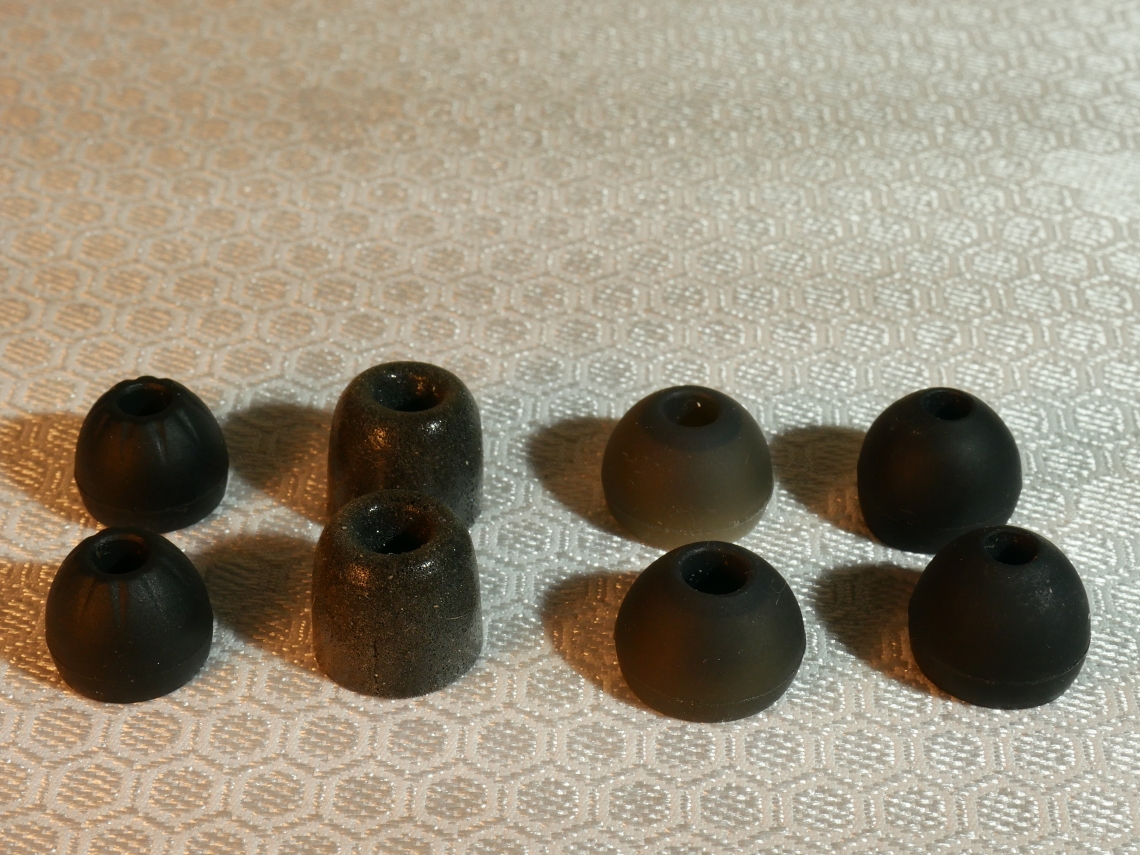
Here I will share with you 4 different ear tips pairing impressions. First of all, the stock Final ear tips is among the best one both in term of comfort and balanced sound rendering. Let’s start with my personal favorite.
The KZ Starline are super cheap ear tips that have a unique conic shape and slightly bigger nozzle holes than average. Strangely, it tends to expand soundstage of any IEM I try it with, sometimes I use Large size for adding length to IEM with big nozzle, but this time I use Medium size so I can push the nozzle deeper in my ears. The fit is perfect and extremely comfortable and more of all it goes deeper than Final ear tips. The sound improvement is very noticeable, especially in soundstage wideness and deepness, but the bass too sounds fuller, giving more sub-bass presence and rounder mid-bass punch, without affecting mids. Treble is slightly more balanced and less forward.
Stock ear tips offer a very flat sound, the bass is very thigh and extends gently, with excellent articulation but you need active listening to hear the nuance as it stays in the background. As well, the soundstage is above average but still a little too intimate for my taste, especially in terms of wideness-tallness. It must be noted that ear tips are very dependant on your own unique ears anatomy, which explains you might have a different result than me.
Memory Foams tips give the worst result, taming bass rumble and impact and making the mids even more intimate and dry. Treble lose it’s sparkle too. The soundstage is the smallest one and the overall sound is very forwards and energic.
Wide bore tips that with short nozzle length is interesting because though it stole some air to the soundstage, the mid-range is pushed slightly forward, making the A8000 more mid centric and very pleasant for vocal. Bass is similar to stock Final ear tips, treble is tighter in attack-decay.
Small hole with long nozzle ear tips (stock one of DITA Fealty) are excellent too, and very similar to KZ but with even taller soundstage. The bass is excellent, sub-bass has good presence and control, slightly less weighty than KZ but more controlled and natural. Mids are similar to stock tips but with more space between instruments, making it less compressed. More I listen to this ear tips pairing, more I might think it’s the best one.
All in all, apart from memory foams tips, the A8000 will never give an underwhelming result with any ear tips, but it must be noted bass response is the frequency range that is the most affected by right ear tips fit for your ears. I still suggest deep insertion to get the best result.
CABLE PAIRING

Now I will test 3 different type of cable, which is 4cores Silver-plated cable (stock cable), high-quality 8cores Litz copper (40$ Audiosense flagship cable) and an 8cores mixed SPC-full copper cable (15$ NiceHCK).
The stock cable offer clearest, sharpest and most neutral sound, it’s as clean as it can get, but tend to keep timbre on the thin side. Bass is really lean too, and treble is vivid. Upper mids are a little hot too.
The Audiosense Crystal Copper 8strand 19 cores 6N OCC Cable offers the best pairing to my ears, the sound is fuller in timbre, bass slightly more weighty and bodied, the vocal gain hint of warmth and highs gain in nuance as if mid treble was boosted and balance better with upper highs. As well, the slight sibilance than can occur in upper mids is better rounded and the whole tonality feels slightly softened. If you own the A8000, you can surely afford this 40$ cable. This perhaps tames treble a bit but balance whole sound too.
The SPC-Copper mixed cable is an excellent pairing too, very similar to Audiosense cable but with slightly more details and clearer sound. Soundstage is bigger than stock cable and mids more fowarded. I think this is the best of both worlds as it delivers fuller-bodied bass and keeps snappy treble that is extremely addictive with the A8000. As well, it’s the cheapest cable, selling around 15$.
SOUND
NOTE: It makes about 2 months I use daily the A8000, so it has at least 300H of burn-in. I thoroughly test it with high multitude of audio sources and amps which include Ibasso DX90, Xduoo X3, Xduoo X20, Xduoo XD-05plus, Tempotec Sonata HD PRO, Fiio BTR5, EARSTUDIO ES100, Xduoo TA-10, JDS LABS ATOM to name a few. What I conclude is that it deserve the clearest AMPING possible, this amping need to be above 250mW @ 32ohm to permit fuller transient response possible. The DAC should be a reference one. For this review, I choose to stick with Dual ES9018 DAC from Ibasso DX90 line out to JDS LABS ATOM. This is my favorite pairing with the Xduoo TA-10 used as a USB DAC-AMP. For portability, the DX90 do a great job as well as FIIO BTR5 balanced. All the music I listen too is at least in 44.1khz/16bit FLAC but I have alot of 48khz/24bit and 96khz/24bit FLAC album too. I listen to a very wide range of music, from old and modern jazz, to chamber classical (mostly baroque composers), post and math rock, indie singers, Soul and R&B and Hip-hop to electronica, experimental, folk and worldmusic.

Welcome into musical reality, enter this cathedral, enter this studio, enter this small room, enter this live concert, the FINAL A8000 can warp you anywhere you want, just be sure to know the quality of your musical destination. With the A8000, the wow effect is within music first of all, how it was recorded and how it is played back. You will hear everything with pristine clarity, not in a surgical way where all very sound is coldly extracted and feel like they play for themself, but in a harmonious heterogeneity that will awake a fresh active listener curiosity. The sound of A8000 reminds me of those of full Planar Headphones like the Hifiman Sundara, but with closed-back dynamic bass and a more edgy definition in the attack that is mostly found with hybrid or multi-balanced armature IEM. With planar, sound projection is fast, but it can be dry in timbre, which the A8000 isn’t, as well, the bass does not extend naturally even if it can have some kind of muffled impact, again, the A8000 is more organic in its cohesion, without lacking in texture which is hyper nuanced yet natural and smooth too.
Everybody raves about the incredible transient speed of the A8000, and indeed it’s for good reason, but if it was wrongly balanced all the energy could have been stoled either by bass or treble, here, the whole sound spectrum is injected with lively dynamic, never struggling to offer a high level of definition of every instrument, whatever the numbers it have. A symphony will be treated with as much respect and minuteness than a solo of violin, a duo of piano and sax, or a slow burner bassy Soul track. The A8000 is the most agile IEM I ever heard, it achieved the pinnacle of sound articulation effortlessly, with incredibly transparent layering that feel infinite in its addition possibility. As much analytical than musical, transparent than lush, the A8000 embrace polarity of sound waves with mind-blowing fluidity.

TONALITY can be simply described as hyper-realist and perfectly balanced and neutral, but let say it’s smoothly brightish too, well polish by acoustic control, free of any tonal imperfection. To me, the term bright feels pejorative for refined tonality of the A8000, because of the high level of naturalness.
TIMBRE is rich and transparent, it’s very complex in numerous nuances that fulfill its texture, but you need active listening to discover every subtle color that fulfill every sound. Sometimes, I get hooked by one instrument and literally crave its musical soul, the cello is a good example of how rich, full-bodied and multi-layered in textures it can be. Vocal too, Violin…timbre is as much highly resolved than highly transparent and never sound artificial or warmed by other frequencies range.
SOUNDSTAGE will differ not only by audio source and amp pairing but the mastering of music you listen too. Greater is clarity, greater is the depth, if it’s play in a big hall, the soundstage will expend in tallness and wideness. It’s out of your head, surrounding you from every side even the back of your head, but mostly from left to right full axis which has extreme deepness. So, yeah, deeper than wider, but it’s already very wide and airy.

IMAGING of this quality coming out of a single dynamic driver IEM wasn’t possible to imagine until I heard the A8000. Even a great 8 balanced armature earphone like the Audiosense T800 cannot offer this level of accuracy and clarity in instrument separation. Neither the DITA Fealty which have a wider soundstage but less sharp definition. With the A8000 you have both spatial placement and transparent layering, no instrument overshadow the other or stole its individuality. I can easily pinpoint any sounds anywhere in the sound spectrum, some will be more distant in the back or at right or left angle, but never drown being opaque sound or congested one against another due to lack of instrument space. It’s as if sound and silence are as fast and important. Razor-sharp precise, cohesive and hyper-realist(again).
BASS is exceptionally flexible, with natural extension that digs to it’s the lower end and highly precise separation between sub, mid and high bass. This isn’t a boring lifeless dry bass that neutral tuning tends to offer, not at all, if your music has recorded rumble it will have this rumble, if the kick is aggressive, the mid-bass will punch with weight. Sub-bass lines are full-bodied with the transparency free of any slow sound wave congestion. The articulation of acoustic bass is fluid, agile and full of natural air resonance, lower is the note, longer is the decay as it should be. No unbalanced sub boost that will affect tonal balance, it’s all-natural here and you will be delighted by your favorite rock album, like the last TOOL ‘’7empest’’ where you follow the grungy bass line and complex drum pattern with great easy, feeling the energy and impact of every note. The mid-bass is ultra-fast and punchy, and do not touch the mids at all, this time, it reminds me of excellently balanced armature mid-bass, the decay is tightly controlled. This is a ‘’multi-forme’’ type of bass response that is surely the most versatile I heard, with boomy electronic or rap, the slam is their, heavy and accurate, it does not ruin the vocal at all. Whatever music style you listen, the bass will never add unwanted warmth or dryness to the sound, and I think this kind of bass can be a masterclass for basshead so they became more aware of the difference between quality and quantity as well as less afraid of well done uncolored bass response. As shown in sub bassy track like ‘’Canadian Hillbilly’’ from GEORGIA ANNE MULDROW the lower bass note do product good amount of rumble, as much felt than heard, and unlike with over bassy IEM, it keeps vocal clear and never become sloppy in lower control, and in another track from the same album like ‘’Overload’’, the sub line is faster, extremely clear and precise, not interfering with thigh well-rounded kick, this track show well the crazy fast transient response as nothing sound unbalanced or shouty, which make this track very over-saturated in grain or congested with inferior IEM.
MID RANGE is always the center of the show with the A8000, and it’s important to say that every instrument keeps their clean space in rich sound imagery. If their any brightness coming from smooth tonality, it’s for better definition, which is beautifully edgy, in the sens ‘’line contour’’ of the sound is clear. This isn’t warm mids that are abstract in macro-resolution or micro-resolution, and it find it’s placed between naturalness and reference sound. It avoid sounding too sharp or analytical due to its transparent ungrainy timbre and cohesive, near fusional in harmony. Piano sound fully accurate, whole note register having a snappy attack, nuanced contract in tonal projection from finger hit on the keyboard to sound expansion that follows with incredible synchronicity. In a track like ‘’Speak no evil’’ from HELGE LIEN TRIO, the hard-hitting piano note in beginning is full of authority and weight, the piano playing perfectly extracts from rest of instrument, nearer of the listener, and as it should, lower note is coming more from center-left and higher notes from center-right. The presentation has a grandeur to it, bigger than life musicality that no concert hall can deliver, and I do not miss one notes because of fast attack and thigh decay, articulation is just mesmerizing, and if I want to concentrate on drummer or bassist, I will be as much wowed by clear accuracy and presence as with the piano. VOCAL have similar treatment, like a mix of lushness in timbre and brightness in tonality, with centered but full presence, clear and detailed without pushing the texture to the point of being distracting with lips movement or breathing, both male and female sound great, never thin or artificial, female vocal can be slightly more forward due to slight extra upper mids push, but I encounter extremely rare sibilance only with the stock cable or with the wrong audio source pairing. The voice of TIMBER TIMBRE is perfect in tonality with just the right amount of body so it keeps the rest of the audio spectrum free of any lows intrusion.
TREBLE is a miracle. A8000 treble is as much delicate than fierce when it need too, and always with extreme control and snappy attack. Rarely I heard the highs so full yet not lacking in both brilliance and sparkle. It’s crisp but have timbre meat too, cymbals crush became more detailed than ever, without the vulgar splash or harshness, again: tightly controlled. Hit-hat is crazy fast, if it has to length 1 microsecond, it will, nothing more. Xylophone became utterly fascinating, as we can follow the whole dynamic of its playing, the hit, the sound and the resonance which will not drown other hit notes. You can mix a lot of different instruments in high range and the clarity will still be as clean, harpsichord, organ, and violin all playing in high range at the same time is no problem and will be mixed in spatiality and layering as needed. Acoustic guitar sound particularly great, with great sparkle in the higher note and perfect delimitation in lower treble, never unbalanced between details, attack, and timbre. We know the treble is fully covered without an important dip in tuning when both acoustic and electric guitar sound as rich and snappy, and this is the case with A8000, whatever the degree of distortion offered by the electric guitar, it will render it meticulously and cohesively. Violin is surely my guilty please with A8000, listening to J.S Bach ‘’Partita for violin solo no1 in B minor’’ by Hilary Hann show the perfect tonal balance of the highs, as well as extremely agile attack, we feel tonal crescendo at every end of melody motif, the lightning-fast bow hit, and higher sound projection when powerful bow slide with more energy. I’m not treble sensitive, but I’m sensible to tonal unbalance in a high range that can make ‘’scream’’ the sound or even ‘’ring’’ it in ultra highs, this does not happen with the A8000, and while treble is energic, it’s not harsh because it’s never grainy, violently edgy, over boosted or artificially analytical. Still, if your preference is laid back delicate highs, the A8000 will perhaps be too vivid and revealing for you. While it’s a very revealing sound, I don’t encounter a lot of bad music rendering, even if mastering wasn’t perfect, but this could affect supreme clarity, which will be fulfilled by recording imperfection.
SONG EXAMPLE
In this sumptuous ARIA from BIBER ‘’Mystery Sonata’’, the full nuance in dynamic range, as well as superbly clear transparent sound layerings, is perfectly shown, in both it’s fast and slow transient response. Slow is the cello, and full-bodied, with realist timbre that project controlled resonance in the clean silence, it’s placement has its own space in spatiality, and the instrument resonance and sound projection go from left to right with great fluidity. We can hear the bow gradually hit and rub the cello string, and produce the sound with perfect tonal contrast, without any details unbalance. When the organ comes in, it’s from the right and sound develop into the center, it’s more distant in the background but keeps great definition both in timbre and impact. Blissful violin fiercely attacks it’s melody line in the middle of two other instruments and is well centered, with greater proximity, the rendering is extremely accurate and agile, showing every edge of attack and tonal change with an excessively flexible transient response. The mix of tempo speed between instrument do not affect transparency, neither the volume change in violin attack create harshness or timbre change. This is truer than life musicality.
In the ultra-heavy sub bassy ‘’Moonlight’’ track from IAMDDB, we have a great example of how heavy and rumbly can go the A8000 driver when it’s needed too. That mix with super thigh kick, snare and percussions, with super clear vocal that has great space between other sound layers, and then the BIG sub line, a thick, grungy, juicy, wall of sub rendered with authoritative weight, real headbanger coming from a 2.5K refinedly tuned IEM. The kick is very snappy-thumpy, wich surprise me, and this beefy bass line….I wasn’t expecting the A8000 to sound that good with trap rap. Spacious HD thigh ass sound right here ma bro. EDIT: I test back this track with Xduoo XD05plus and bass gain, the sub was even thicker, heavier and mids bass punchier….basshead for real and extremely well controled and juicy. Clarity was still way above average. This beryllium driver can handle alot of extra bass boost EQ. Interesting!
All arounder you say? The A8000 really can deal with any type of music, but I will not pass through everything here, it’s already done in my 2 months of use. IDM sound punchy, detailed, extremely, please. Soul or R&B has a superbly clear voice. And now, this jazz-rock band is no exception, and A8000 excel to render this track even more alive. The separation between electric bass and guitar is just so fabulously layering, you can hear both playing together with ultimate articulation, the bass has a nice texture to it and a grungy body. The electric guitar is fast and tight, so rich in tone change and when it uses wah pedal the sound is elastic, thigh and euphonious. Kick is weighty, hit-hat have a fast pace, splash cymbals are extremely realist with long extension that is never harsh. In fact, while the presentation is vivid, dynamic and ultra-clear, it’s never overly bright, more reference sounding with extra musicality. Yes, the A8000 do know how to Rock.
COMPARISONS

VS MEZE RAI PENTA (1100$)
Both these items are real lookers and extremely well crafted, but in terms of comfort, I will give it to the more organically and curvy shaped PENTA , which is just among the most smooth fitting IEM I ever use. Their housing smaller and lighter, without a hard angle like the bigger and sharper A8000.
In term of sound, they are the complete opposite, as an Astro physician vs poet kinda difference. Hum, but for MEZE the poet will be a slammer in fact, because the bass is near basshead style, at least, compared to more realist, flat but not tamed bass response of A8000. For audiophile sound, the PENTA are tuned into fun, laidback and thick sound, not as a reference and neutral like the more mature A8000. Yes, brighter, sharper and edgier is the A8000, warmer, easier and smoother is the MEZE. MIDS aren’t warmed by the bass and has more energic upper mids with the A8000, whole transient response, dynamic, and attack are notably faster, snappier and better resolution, and instrument like guitar, violin and piano will sound clearer in the definition. The MEZE will struggle with its thick juicy bass that interferes with overall clarity, adding meat to timbre but saturating silence between the instrument. TREBLE of MEZE is laid back, natural and again smoot and thick, but it isn’t crips and snappy as the vivid A8000 that offer such speed that you literally feel the weighty hit of a bows on the violin while this same violin will sound relaxed with the PENTA. Unexpectedly, the SOUNDSTAGE is wider with the PENTA, but unexpectedly it’s way deeper with the A8000 due to supreme black background. IMAGING while being more intimate is seriously sharper in instrument placement than the thick layered wall of sound of MEZE.
All in all, the A8000 is a technical winner with more neutral sound and superior clarity, while the PENTA is free of any harshness as well as a lot of micro-details and nuances that affect overall resolution.
VS DITA FEALTY (1400$)
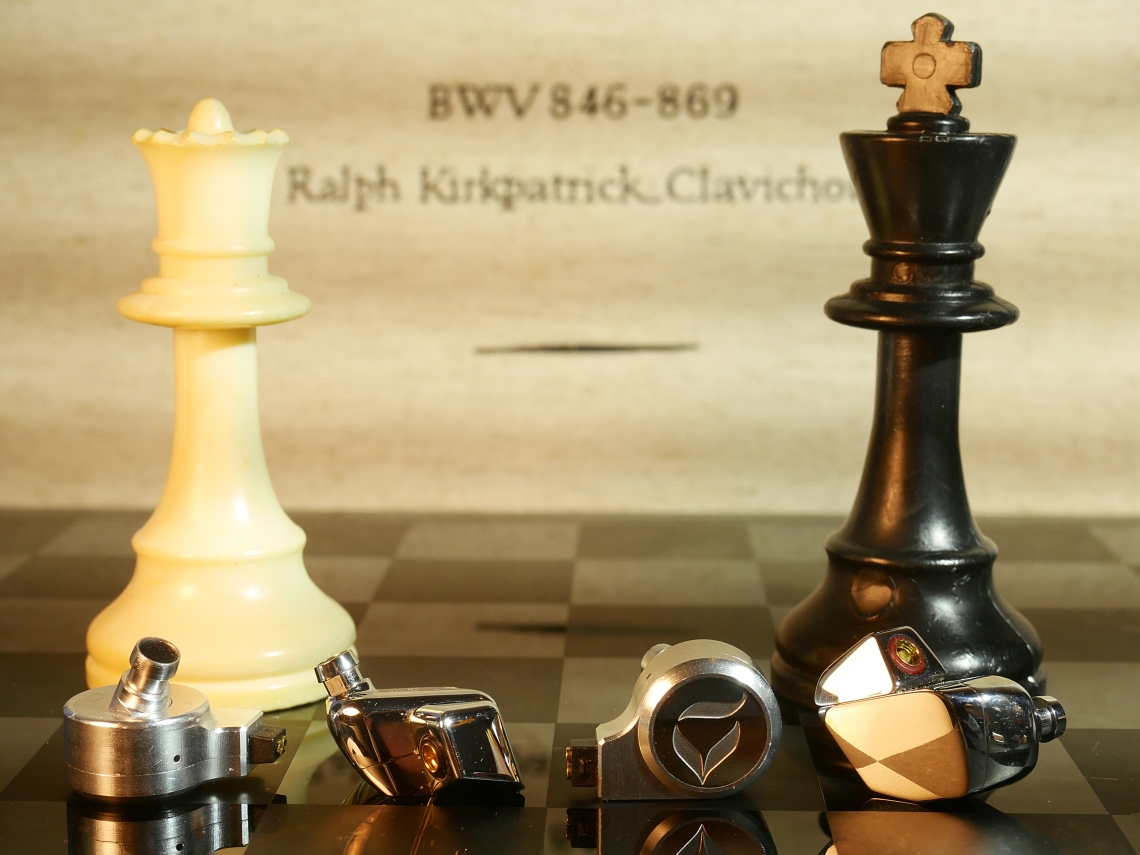
Now, in terms of construction and comfort, the A8000 is clearly superior. SOUNDSTAGE is quite wider and more holographic and airy with the DITA, this will give more space between instrument but the number of instruments will struggle more for proper IMAGING due to slower transient response. Still, A8000 sound like an on-ear open-back headphone while the DITA is more similar to an open back in headroom size. BASS is where I find the A8000 more realist, it extends better and has more body as well as less dry timbre, the DITA bass is a rather thin and tonal balance between low and mids is less cohesive than A8000, which make instruments like cello lack a bit of body. MIDS are slightly more recessed with the DITA, they are drier, brighter and thinner with smoother definition, while the A8000 is more edgy and natural in tonality. Piano sound fuller with the A8000 and vocal closer and clearer, but more intimate, though mids aren’t the smoothest one with A800, the DITA upper mids are more aggressive and affect the tonal balance of vocal, making them sound wider, but thinner and harsher too. TREBLE is brighter with more emphasis in upper highs with the DITA, which tend to push forwards percussions and affect overall naturalness of tonality and stole some definition to mid treble where the A8000 have plenty of it, so the highs are more bodied and in line with rest of audio spectrum. I feel the highs are crisper and more sparkly with the A8000, which gives a fabulous performance for both acoustic and electric guitar, while the DITA is more on the metallic side.
All in All, these two are fabulous listen, slightly similar in overall bright tonality but with more balanced and natural sound for A8000 and more holographic airy sound for the Fealty.
VS FINAL AUDIO B1 (700$)
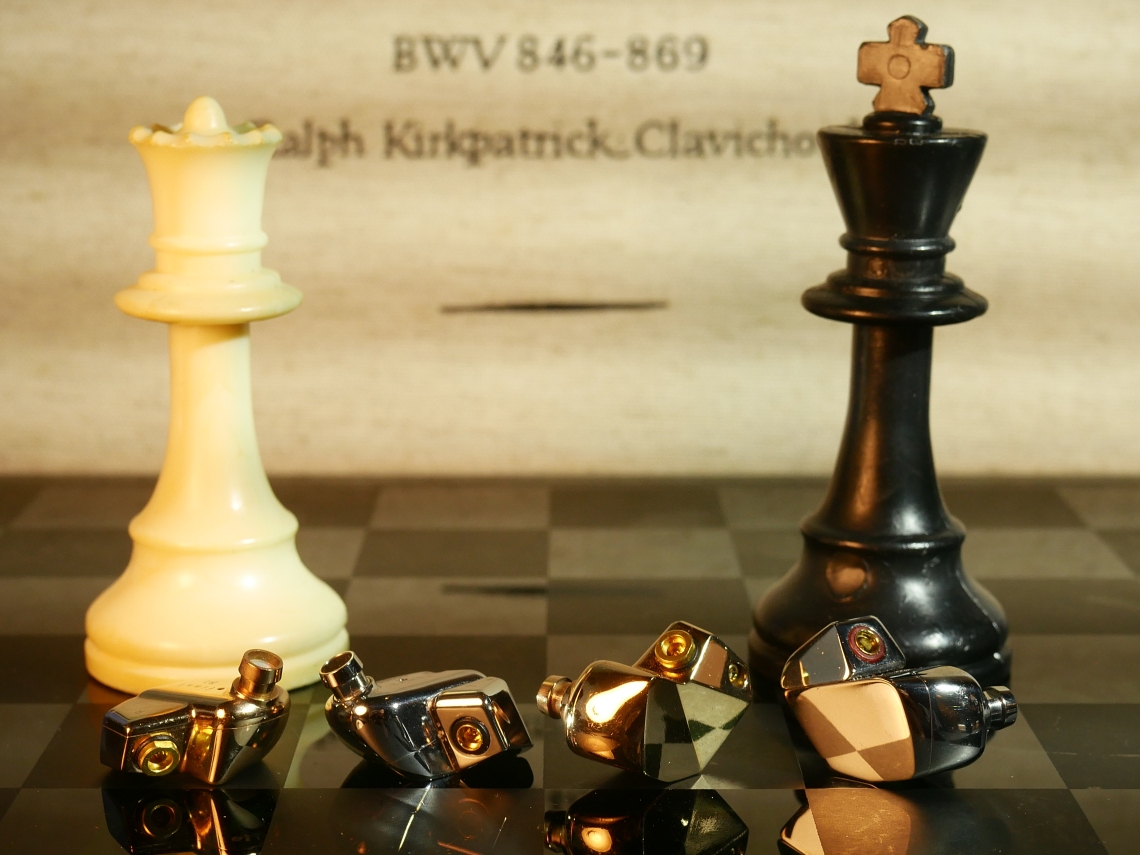
The B1 is a Hybrid IEM with one Dynamic and one balanced driver, it’s the flagship of B series and 3 times less expensive than A8000. Construction is on par with a mirror finish too but of golden color, the A8000 is notably bigger so he’s little less comfortable. Now, both have similar SOUNDSTAGE apart for extra deepness of A8000, IMAGING is clearer in positioning as well as instrument separation space with A8000. BASS is notably more boosted and warmer with B1, it has more emphasis in sub-ass and lack speed and mid-bass separation of A8000 which have flatter more textured timbre too as well, it feels it extend down to 20khz with more realist tonal balance. MIDS are lusher, thicker and warmer with the B1, lacking high resolution and edgy attack of A8000, this tend to mix vocal with rest of instrument, offering a presence that stole instrument layering while the A8000 keep the individuality of every instrument and offer a well centered and intimate vocal presentation. TREBLE is more relaxed with the B1, it lacks snappy attack and crispness of A8000 but makes the B1 less aggressive and more natural, for micro-details lovers the B1 is way more inferior in term of both definition and resolution and can make the musicality lack in highs energy.
All in all, the A8000 is from another league in term of clarity, technicalities and accurate articulation of music, but do not sound as natural and smooth as the bassier-warmer B1.
CONCLUSION

The FINAL AUDIO A8000 delivers nothing less than epiphany of audio fidelity, some will consider them reference sounding, other neutral or even natural, and this is because the sound is so rich and complex in nuance, that you cannot easily categorize it’s unique musicality as versatile and surprising in tonality and timbre.
Sure, the highlight here it’s the incredibly refined technicalities, the lightning-fast transient response, the high level of clarity and precise multi-layered and transparent imaging. But the A8000 is more than just technically talented, and you will only discover it’s full potential by testing as much different music style as possible. Sometime the bass will wow you, other times it will be the vocal, other time instrument presence and timbre, other times the vivid details, you really travel within the own A8000 universe and saying it’s addictive is an understatement.
The A8000 have the balance of E4000, the speed of F41000, the edgy attack of B3, and it’s own unique bass response. This is perhaps the only End Game flagship IEM you will ever need because it injects extra life to any type of music without being overly analytical or unforgiving.
Sure, 2000$ is a lot of money, but if you are wealthy enough and search for an audiophile reference sound that lacks nothing from lows to highs and offers crisp and transparent imaging, the A8000 will pass the test of time due to its near-neutral sound that can deal with any music style.
The FINAL AUDIO A8000 are the best earphones I ever try, and they still find a way to impress me with their hyper-realist lively musicality even after 2 months of intense use. You cannot get enough of this audiophile luxury.



